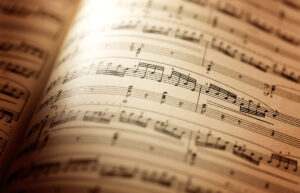The Texture in Music: A Comprehensive Guide 2023

Discover music texture in our 2023 guide. Explore its essence, evolution, and instrument roles. Learn about density and texture diagrams. Understand its importance and types, and find tips for enhancing compositions.
Welcome to TheDemoStop, now join the community!
Connect with artists, fans and producers around the world.
What is texture in music?
Music texture encompasses the interplay of melody, harmony, and rhythm, defining the overall sound and structure of a piece. It dictates how various musical elements combine to create complexity or simplicity. This interplay profoundly influences the composition’s mood and character.
History of texture in music
Throughout history, music texture has undergone fascinating changes. The medieval era favored monophonic texture, exemplified by Gregorian chants. The Renaissance created polyphony, showcasing intricate harmonies by composers like Palestrina and Josquin des Prez. The Baroque period introduced homophonic textures featuring textured compositions from Bach and Handel.
The Classical era blended homophony and polyphony through composers like Mozart and Haydn. The Romantic era explored lush, emotional textures with Beethoven and Tchaikovsky employing orchestral timbres. The 20th century marked an era of experimental textures, pushing musical boundaries. Today, contemporary music combines various textures for unique sonic experiences, illustrating music’s ever-evolving landscape of creativity and expression.
What is texture in music?
Texture encompasses how various musical elements interact to define the music’s overall sound and feel. It’s often categorized as thick or thin, dense or sparse. The most common music texture types are monophonic, homophonic, and polyphonic. Understanding these textures is vital for comprehending and enjoying the depth and complexity of music compositions.
Identify the instruments
Recognizing instruments by their sound characteristics is key to understanding music texture. This skill involves discerning factors like tone, range, harmonics, and playing techniques. For instance, you can distinguish a cello’s warm tones from a trumpet’s bright notes. This ability unveils the intricate musical textures and aids in pinpointing the contributing instruments.
Role of an Instrument:
In music, instruments play four primary roles:
- Melody – This is the central element, forming the core structure of a composition.
- Beat – Typically carried by percussion instruments, it sets the rhythm for listeners to follow.
- Melodic accompaniment – These instruments add depth and harmony, supporting and enriching the main melody.
- Rhythmic accompaniment – Such instruments, like drums, enhance the rhythm and energy of a piece, providing intricate patterns and accents for a textured feel.
Describe the density
Density in music texture refers to how packed or layered the musical elements are in a composition. It indicates the number of voices or instruments contributing to the overall sound at a given moment. This aspect is crucial in shaping a composition’s emotional impact and complexity.
Composers use density to create moments of tension, release, and subtle nuances, allowing them to craft the emotional essence of their music. Understanding density in musical texture is valuable for composers and listeners, providing insights into the intricacies and depth of a musical work.
Texture in music diagram
A music texture diagram visually represents how different musical elements interact within a piece. It typically displays multiple lines, each representing different voices or instruments, with vertical positioning indicating pitch. These diagrams show stacked lines representing various voices or instruments, a horizontal axis denoting time, overlaps or connections indicating interactions, labels clarifying each part, and symbols denoting dynamic changes like crescendos or decrescendos.
Music texture diagrams offer a visual summary of a composition’s structural components, aiding in the analysis and understanding of how diverse musical elements work together to create the intended texture.
Why is texture in music important?
Music texture shapes our perception of a composition, adding depth and character. It coordinates melody, harmony, and rhythm to create a unified musical experience, evoking emotions and setting the atmosphere. Texture also aids in storytelling, reflecting the tension and emotions in the lyrics. It plays a vital role in establishing the composition’s mood, whether a simple or complex texture, allowing composers to convey their artistic vision and connect with the audience on intellectual and emotional levels.
Welcome to TheDemoStop, now join the community!
Connect with artists, fans and producers around the world.
4 types & examples of texture in music
Four fundamental types of musical textures exist, each influencing a composition’s overall character and sound.
Monophony
Monophony is a foundational music texture characterized by a single melodic line or voice without harmonic accompaniment. A prime example of monophonic texture can be found in the Gregorian chants of the medieval era.
Polyphony
Conversely, polyphony embodies a musical texture where multiple independent melodic lines or voices are performed concurrently. A notable example of polyphonic texture can be observed in Bach’s fugues, where distinct voices carry their melodies.
Orchestral Polyphony
Orchestral polyphony encompasses the intricate interweaving of multiple independent melodic lines within an orchestral composition. Renowned composers like Mozart and Beethoven have crafted notable examples of this texture.
Heterophony
Heterophony characterizes a musical texture in which several performers or voices render a similar melody, each infusing it with slight variations, resulting in a complex and detailed sonic tapestry. Traditional folk music often serves as a representation of heterophony.
Tips for Improving the Overall Texture in Music
Enhancing the overall texture of music is about refining specific elements to create a richer and more engaging sound. Here are three essential tips:
Dynamics
Dynamics encompass variations in the volume and intensity of a music piece. By incorporating changes in loudness and softness, musicians can infuse depth and emotion into their compositions. Experimenting with dynamics can emphasize specific elements, like building anticipation through a crescendo or evoking a calm, introspective atmosphere with decrescendo.
Articulation
Articulation pertains to how individual notes are played or sung, influencing musical sound clarity, attack, and release. Using accents, tenuto marks, and other notations can mold a composition’s character. Experimenting with different articulation styles offers a diverse and textured listening experience.
Tone Color (Timbre)
Timbre, often described as the “color” of sound, plays a significant role in shaping musical texture. It reflects the unique quality and character of sounds. Different instruments and voices have distinctive timbres contributing to the overall sound. For example, blending the warmth of strings with the brilliance of brass instruments or contrasting the timbre of a soprano voice with a baritone voice can create rich, multi-layered textures.
Welcome to TheDemoStop, now join the community!
Connect with artists, fans and producers around the world.
Conclusion
This extensive guide has provided insights into various facets of musical texture. Here are the key points to remember:
- Understanding Texture in Music: Texture in music defines how musical elements like melody, harmony, and rhythm combine.
- Historical Evolution: Musical texture has evolved throughout history, from monophony in the medieval era to polyphony in the Renaissance, homophony in the Baroque period, and experimental textures in contemporary music.
- Identifying Instruments: Recognizing instruments by their unique sound qualities is a valuable skill. Understanding factors like tone, range, harmonics, and techniques allows listeners to pinpoint contributing instruments.
- Roles of Instruments: Instruments take on key roles in a composition, including the melody, beat, melodic accompaniment, and rhythmic accompaniment, shaping the character and depth of a piece.
- Density: The density of a musical texture, indicating the number of voices or instruments in a composition, is a powerful tool that composers use to create emotional impact and intricacy.
- Music Texture Diagrams: Visual diagrams illustrate how musical elements interact within a composition, aiding in understanding the structure and arrangement of a music piece.
- Significance of Music Texture: Texture is crucial for shaping a composition’s mood, conveying emotions, and telling a musical story. It adds complexity, fullness, and personality to the music, making it an essential element in musical expression.
- Types of Texture: There are four fundamental types of music texture – monophony, polyphony, orchestral polyphony, and heterophony.
- Improving Music Texture: Musicians can enhance music texture by focusing on dynamics, articulation, and timbre(tone color).
FAQs
What does texture mean in music?
In music, texture refers to the way different musical elements combine to create the overall sound of a composition. It’s like the fabric of a musical piece, determining whether it sounds thick or thin, complex or simple.
What is texture in music?
Texture in music refers to how various musical voices interact and contribute to building a composition’s structure. It characterizes how musical elements interact, layer, and intertwine to shape the music’s character.
What are the different types of texture in Music?
There are four primary types of texture in music such as monophony, polyphony, orchestral polyphony, and heterophony.
Why is texture important in music?
Texture in music is important because it adds depth and richness to the listening experience. It shapes the way melodies and harmonies interact, conveying emotions and enhancing musical narratives. By varying textures, composers can evoke different moods and emphasize various elements of a piece, making it a powerful tool for musical expression and communication.
What are the examples of texture in music?
An example of monophony texture is Gregorian chants, polyphony texture is a fugue by Bach, and heterophony texture is traditional folk music.
How to describe texture in music?
Describing texture in music can be achieved through diagrams that represent various musical elements like melody, harmony, and instrumentation. These diagrams visually illustrate how these elements interact, providing a clear depiction of the music’s texture, whether it is monophonic, polyphonic, or homophonic.
What is Polyphonic Texture?
Polyphonic texture in music refers to a style where multiple independent melodies are played or sung simultaneously, creating intricate harmonies. Polyphony is a hallmark of the Renaissance period and contributes to rich, complex, and captivating musical compositions.
What is Monophonic Texture?
Monophonic texture in music is a single melodic line or voice without harmony. It’s like a solo singer or a solo instrument playing a melody without accompaniment.
What is Heterophony Texture?
Heterophony texture is a musical style where multiple performers play slightly different variations of the same melody simultaneously. It creates a unique and rich sound as each performer adds their interpretation to the shared theme.































































